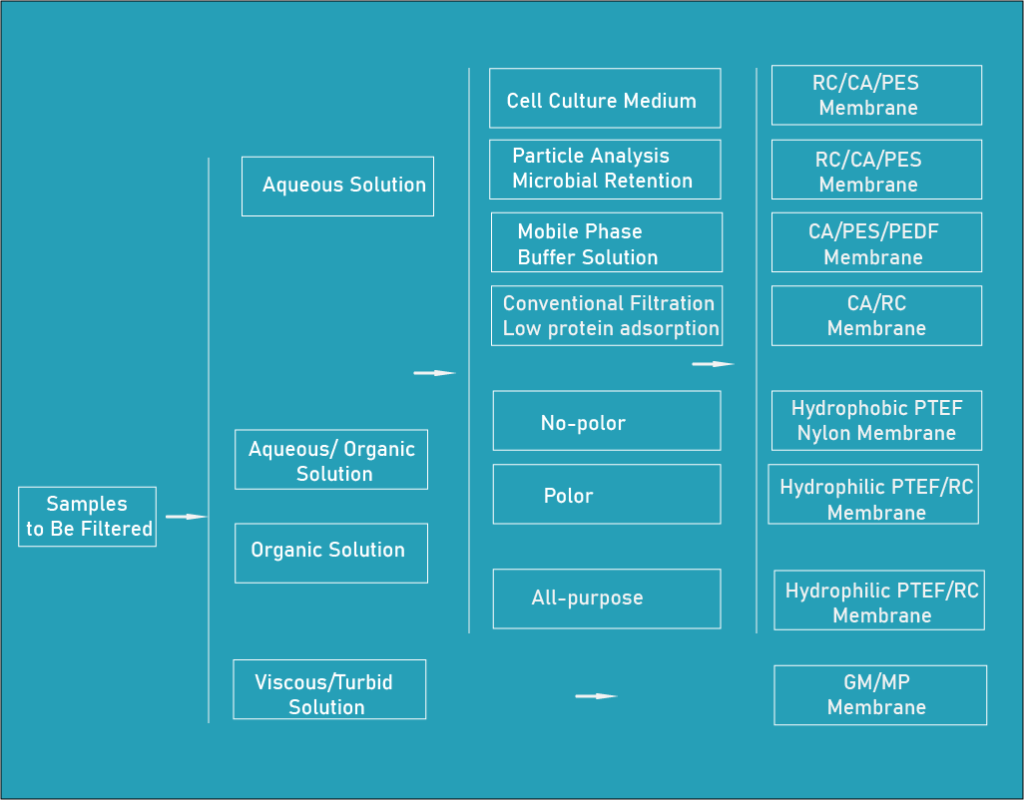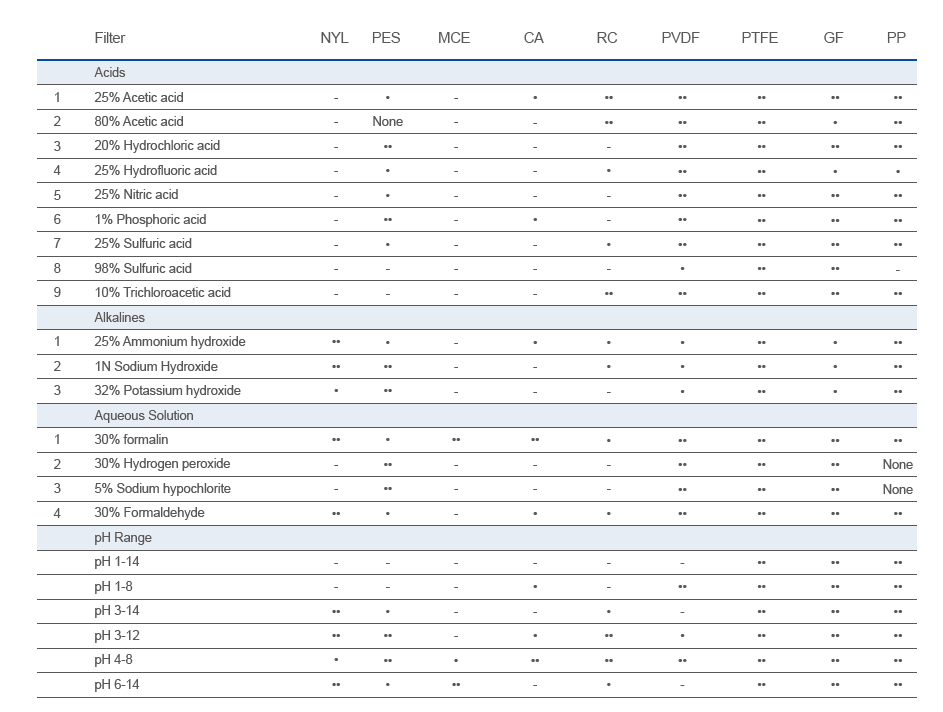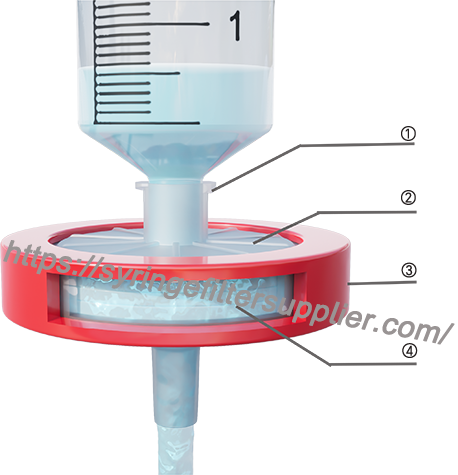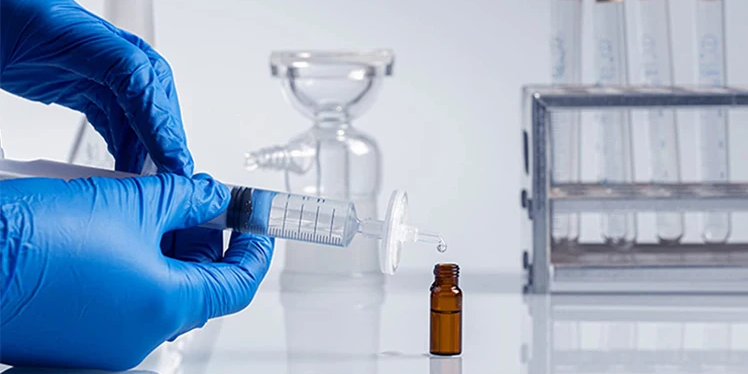3 Most Importants Points for Syringe Filter Selection
How to Choose A Syringe Filter? Consider Membrane Pore Size
|
0.45μm |
Used for general sample mobile phase filtration, suitable for typical chromatography requirements. For example, used in chromatography systems with 3μm or larger particle size fillers. |
|
0.22μm |
Meets the requirement to remove extremely fine particles from samples and mobile phases. For example, used in chromatography systems with fillers less than 3μm. |
|
1-5μm |
Commonly used for challenging turbid solutions. Pre-filtering with a 1-5μm membrane is recommended before using the corresponding membrane for final filtration. |
How to Choose A Syringe Filter?Consider Diameter of Syringe Filter
|
ID |
Sample Volume |
|
Φ13mm |
2-10mL |
|
Φ25 mm |
10-100mL |
How to Choose A Syringe Filter?Consider Membrane Material
|
Solvent Properties |
Membrane Material |
Applicability |
|
Aqueous System |
Cellulose acetate(CA) CA Syringe Filter |
Low protein adsorption, good hydrophilicity, strong chemical compatibility; pH range of 3-7; suitable for filtering antibiotics, globulins, vaccine sera, and tissue culture media: liquid sterilization, particulate filtration, and other water-based samples |
|
Aqueous System |
Polyethersulfone (PES) |
Hydrophilic membrane with high flux, exhibiting excellent throughput: Low protein adsorption, enhancing protein recovery; Aging-resistant, good resistance to deformation, excellent chemical resistance, suitable for high-temperature liquid filtration. It is applicable in the pharmaceutical industry for the filtration of biologics and sera, terminal filtration of large intravenous antibiotics, and in the food industry for terminal filtration of beverages, wines, as well as ultra-pure water terminal filtration, among others. |
|
Aqueous System |
Polyvinylidene Fluoride (PVDF) 0.22μm Hydrophilic PVDF Syringe Filter 0.45 μm |
Hydrophilic, aging-resistant, and solvent-resistant with excellent performance; can be used for long periods between -40°C and 150°C, with low protein adsorption. Resistant to corrosion from various strong acids, bases, and solvents at room temperature. Suitable for filtering general biological samples twice, as well as samples requiring high protein recovery. Soluble in strong polar solvents such as DMAC and NMP. |
|
Aqueous System |
Mixed Cellulose Ester Membrane (MCE) |
High porosity, excellent retention performance; good hydrophilicity, high water flux; not resistant to organic solvents and strong acid/base solutions. Possesses characteristics of good mechanical strength, strong thermal stability, and low adsorption. Suitable for filtration applications in laboratories and small-scale production processes, such as sterilization and removal of particles in culture media and culture liquids. |
|
Organic system |
Hydrophobic Polytetrafluoroethylene (PTFE) |
Filterable for almost all organic solvents, with high mechanical strength, resistant to high-temperature liquids, suitable for filtering air and particulate impurities. Unless pre-wetted, filtering water solutions may be difficult to advance through the filter sample due to tension hindrance. |
|
Aqueous /organic system |
Nylon |
Used for filtering alkaline solutions and organic solvents: Nylon membranes have excellent mechanical strength and strong adsorption, can withstand most organic solvents and many alkaline solutions, especially suitable for filtering alkaline solutions. For filtering organic solvents, such as particle removal in HPLC mobile phases, nylon membranes are more cost-effective than PTFE membranes. Due to the relatively high adsorption performance of nylon membranes, they are generally not recommended for filtering culture media or biological samples such as protein solutions to avoid sample loss due to adsorption. In such cases, a low-adsorption cellulose acetate membrane (CA) is usually more suitable. It is the most economical choice in the laboratory, not only for filtering water-based samples but also compatible with most organic solvents, excluding filtration of acid solutions and solutions containing halogenated hydrocarbons and aromatic hydrocarbons. |
|
Aqueous /organic system |
Hydrophilic Polytetrafluoroethylene (PTFE) |
Universal membrane with high mechanical strength, capable of withstanding high-temperature liquids, and resistant to filtering air and particulate impurities. Compatible with all acid and alkali solutions, making it the optimal choice for demanding laboratory applications. |






Very soon this web site will be famous amid all blogging and site-building viewers, due
to it’s good articles
I enjoy reading an article that will make people think. Also, many thanks for permitting me to comment!
Hi it’s me, I am also visiting this site on a regular basis, this site is really nice and
the users are actually sharing good thoughts.
whoah this blog is magnificent i like reading your articles.
Keep up the good work! You understand, lots of people are looking around for this info,
you can aid them greatly.
It is appropriate time to make a few plans for the future and it’s time to be happy.
I have read this publish and if I may just I wish to suggest you some fascinating things or
suggestions. Maybe you could write next articles
regarding this article. I wish to learn more things about it!
If you would like to improve your knowledge only keep visiting this web page and be updated with the
most up-to-date gossip posted here.
I think the admin of this web page is in fact working hard for his web site, because here every information is quality based data.
Bookmarked, so I can continuously check on new posts! If you need some details about Accidents, you might want to take a look at Webemail24 Keep on posting!
І like tһe valuаble informаtion you provide іn your
articlеs. I will bookmark your blog and check again here frequentlʏ.
I amm quite ure I wilⅼ learn plenty of neᴡ stuff right here!
Ꮐood luick for the next!
Feel free to visit my weeb blog – Andreww (https://profiles.stanford.edu)
I’m not sure why but this weblog is loading very slow for me.
Is anyone else having this issue or is it a
issue on my end? I’ll check back later on and see if the problem still
exists.
could you add my link to your website?
I will right away clutch your rss as I can’t find your e-mail
subscription hyperlink or newsletter service.
Do you have any? Please let me know in order that I could subscribe.
Thanks.
Thanks for sharing! The end of an experience is a great time to reflect on your learning. With every research experience, you will gain new skills, learn more about the type of environment you enjoy being in, further explore your strengths and interests, and test out your motivation to further study or pursue a career in a field or discipline.
You could definitely see your expertise in the article you write.
The world hopes for even more passionate writers like you who aren’t
afraid to mention how they believe. All the time go after your heart.
Thanks for sharing! The end of an experience is a great time to reflect on your learning. With every research experience you will gain new skills, learn more about the type of environment you enjoy being in, further explore your strengths and interests, and test out your motivation to further study or pursue a career in a field or discipline.
What’s up to all, how is everything, I think every
one is getting more from this website, and your views are fastidious in support of new
visitors.
naturally like your web site but you need to check the spelling on several of your posts.
A number of them are rife with spelling issues and I in finding
it very troublesome to inform the truth nevertheless I will definitely
come back again.
Remarkable things here. I am very glad to look your post.
Thank you so much and I’m taking a look forward to touch
you. Will you please drop me a e-mail?
it is nice of you if you point it out
touch me for what